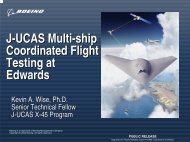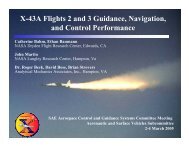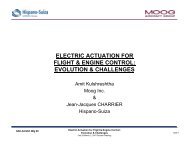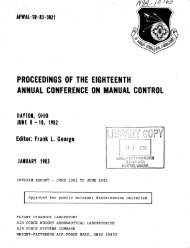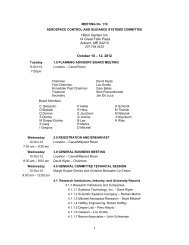Report of the Second Piloted Aircraft Flight Control System - Acgsc.org
Report of the Second Piloted Aircraft Flight Control System - Acgsc.org
Report of the Second Piloted Aircraft Flight Control System - Acgsc.org
Create successful ePaper yourself
Turn your PDF publications into a flip-book with our unique Google optimized e-Paper software.
Magpltude <strong>of</strong> <strong>the</strong> desired output. - Because <strong>the</strong> character <strong>of</strong> <strong>the</strong><br />
response is determined by <strong>the</strong> magnitude <strong>of</strong> <strong>the</strong> desired output, a value<br />
<strong>of</strong> <strong>the</strong> output magnitude must be selected for design purposes. In general<br />
this information is obtained from <strong>the</strong> process which <strong>the</strong> servomotor is<br />
varying and consists <strong>of</strong> an estimation <strong>of</strong> <strong>the</strong> maximum percent change in<br />
<strong>the</strong> process tht is required to occur in a given traneient or sine wave<br />
oscillation. This variation should <strong>the</strong>n be translated into <strong>the</strong> output<br />
stroke required <strong>of</strong> <strong>the</strong> servomotor to produce such a change. The total<br />
stroke <strong>of</strong> <strong>the</strong> servomotor will usually be larger than <strong>the</strong> design value<br />
<strong>of</strong> S or St and corresponds to.<strong>the</strong> steady state range through which<br />
<strong>the</strong> process is carried. If a step change or sine wave oscillation larger<br />
than S or St is introduced <strong>the</strong> resulting inertia index will be larger<br />
than that assumed in <strong>the</strong> design with <strong>the</strong> consequent possibility <strong>of</strong> damage<br />
from high peak cylinder pressures. Protection against such damage can<br />
be obtained by restricting <strong>the</strong> length <strong>of</strong> <strong>the</strong> pilot valve lands.<br />
Selection <strong>of</strong> no-load time constant and inertia index for frequency<br />
response requirements. - If <strong>the</strong> frequency response requirements <strong>of</strong>, <strong>the</strong><br />
servomotor are known <strong>the</strong>y in general will take <strong>the</strong> form <strong>of</strong> <strong>the</strong> first<br />
break frequency (f l) and <strong>the</strong> &oesover frequency (f3). The equations<br />
for T and E' in term <strong>of</strong> <strong>the</strong>se two frequencies are as follows:<br />
As shown in <strong>the</strong> analysis <strong>the</strong> response <strong>of</strong> a servomotor <strong>of</strong> this type is<br />
characterized in both attenuation and phase shift by a first order relation<br />
up to <strong>the</strong> crossover frequency. The phase shift in this frequency<br />
band is <strong>the</strong>refore limited to a maximum value <strong>of</strong> 90'. The crossover frequency<br />
f3 can <strong>the</strong>refore be selected on <strong>the</strong> basis <strong>of</strong> sufficient amplitude<br />
attenuation at 90' phase shift to insure stability in <strong>the</strong> control loop.<br />
With fl and fg defined, <strong>the</strong> dimensions <strong>of</strong> <strong>the</strong> servomotor are established.<br />
Substituting equations (23) and (24) in equation (21) <strong>the</strong> following<br />
relation is obtained:<br />
4MS1p<br />
2<br />
flf3<br />
(251<br />
From equation (25) it can be seen that at a fixed value <strong>of</strong><br />
fl an increased<br />
margin for fg can only be obtained by a proportionate increase in piston<br />
area.<br />
Selection <strong>of</strong> no-load time constant and inertia index for transient<br />
response requirements. - Transient response requirements can be expressed<br />
in tern <strong>of</strong> <strong>the</strong> time to reach 90 percent '<strong>of</strong> <strong>the</strong> final value. The




